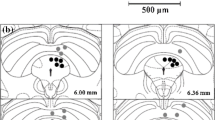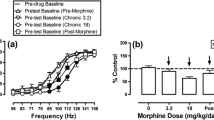Abstract
The effect of a selective ℵ-opioid agonist, U-50, 488H, on wet-dog shaking (WDS) induced by hippocampal stimulation was investigated and compared with that produced by morphine. U-50, 488H, as well as morphine, inhibited the appearance of WDS in a dose-dependent manner. U-50, 488H was approximately three times more potent than morphine in this effect. Neither drug showed any effect on hippocampal afterdischarge. The inhibition of WDS produced by U-50, 488H was blocked significantly by a ℵ-opioid antagonist, MR-2266, but not by naloxone. On the other hand, the inhibitory effect of morphine was completely antagonized by both MR-2266 and naloxone. The present results strongly suggest that not only μ-but also ℵ-opioid receptors are involved in the appearance of WDS induced by hippocampal stimulation.
Similar content being viewed by others
References
Araki H, Aihara H (1985) Effects of morphine and neuroleptics on wet-dog shaking behavior elicited by hippocampal stimulation in rats. Psychopharmacology 85:301–305
Bedard P, Pycock CJ (1977) ‘Wet-dog’ shake behavior in the rat: A possible quatitative model of central 5-hydroxytryptamine activity. Neuropharmacology 16:663–670
Bloom F, Segal D, Ling N, Guillemin R (1976) Endorphins: Profound behavioral effects in rats suggest new etiological factors in mental illness. Science 194:630–632
Bloom FE, Rossier J, Battenberg ELF, Bayon A, French E, Henriksen SJ, Siggins GR, Segal D, Browne R, Ling N, Guillemin R (1978) β-endorphin: Cellular localization, electrophysiological and behavioral effects. In: Costa E, Greengard P (eds) Advances in biochemical psychopharmacology, vol 18. Raven, New York, pp 89–110
Drust EG, Sloviter RS, Connor JD (1981) Methionine enkephalin-induced shaking behavior in rats: Dissociation from brain serotonin mechanisms. Neuropharmacology 20:473–475
Gianutsos G, Drawbaugh RB, Hynes MD, Lal H (1975) The narcotic withdrawal syndrome in the rat. In: Ehrenpreis S, Neidel EA (eds) Methods in narcotic research. Marcel Dekker, New York, pp 293–309
Lanthorn T, Isaacson RL (1978) Studies of kainate-induced wet-dog shakes in the rat. Life Sci 22:171–178
Le Gal La Salle G, Cavalheiro EA (1981) Stimulation of septal and amygdaloid nuclei: EEG and behavioral responses during early development of kindling with special reference to wet-dog shakes. Exp Neurol 74:717–727
Le Gal La Salle G, Cavalheiro EA, Feldblum S, Maresova D (1983) Studies of wet-dog shake behavior induced by septohippocampal stimulation in the rat. Can J Physiol Pharmacol 61:1299–1304
Lerner-Natori M, Rondouin G, Baldy-Moulinier M (1984) Evolution of wet-dog shakes during kindling in rats: Comparison between hippocampal and amygdala kindling. Exp Neurol 83:1–12
Martin WR (1967) Opioid antagonists. Pharmacol Rev 19:464–521
Martin WR, Wikler A, Eades CG, Pescor FT (1963) Tolerance to and physical dependence on morphine in rats. Psychopharmacologia 4:247–260
Martin WR, Eades CG, Thompson JA, Huppler RE, Gilbert PE (1976) The effects of morphine- and nalorphine-like drugs in the nondependent and morphine-dependent chronic spinal dog. J Pharmacol Exp Ther 197:517–532
Paxinos G, Watson C (1982) The rat brain in stereotaxic coordinates. Academic Press, New York
Römer D, Buscher H, Hill RC, Maurer R, Petcher TJ, Welle HBA, Bakel HCCK, Akkerman AM (1980) Bremazocine: A potent, long-acting opiate kappa-agonist. Life Sci 27:971–978
Slater P (1984) Pharmacological profile of wet-dog shaking induced by electrical stimulation of the fornix in rats. Pharmacol Res Commun 16:273–280
Tang AH, Collins RJ (1985) Behavioral effects of a novel kappa opioid analgesic, U-50, 488, in rats and rhesus monkeys. Psychopharmacology 85:309–314
Turski L, Czuczwar SJ, Turski W, Kleinrock Z (1981) Studies of carbachol-induced wet-dog shake behavior in rats. Psychopharmacology 73:81–83
Von Voigtlander PF, Lahti RA, Ludens JH (1983) U-50,488: A selective and structurally novel non-mu (kappa) opioid agonist. J Pharmacol Exp Ther 224:7–12
Wei E, Sigel S, Loh H, Way EL (1975) Thyrotropin-releasing hormone and shaking behavior in rat. Nature 253:739–740
Yamada K, Matsuki J, Furukawa T (1983) Wet-dog body shaking induced by electrical stimulation of hippocampus in the intact and reserpinized rat. Res Commun Chem Pathol Pharmacol 39:29–37
Author information
Authors and Affiliations
Rights and permissions
About this article
Cite this article
Ohno, M., Yamamoto, T., Araki, H. et al. The effect of ℵ-opioid agonist U-50, 488H on wet-dog shaking behavior induced by hippocampal stimulation in rats. Psychopharmacology 91, 189–192 (1987). https://doi.org/10.1007/BF00217060
Received:
Issue Date:
DOI: https://doi.org/10.1007/BF00217060




